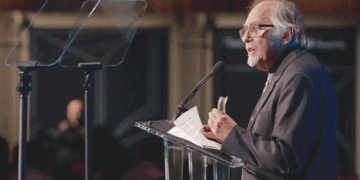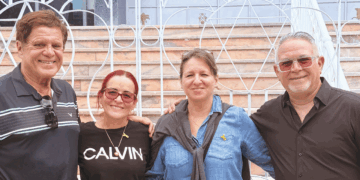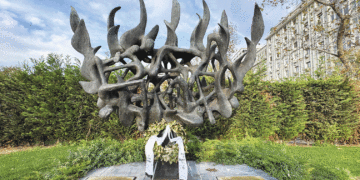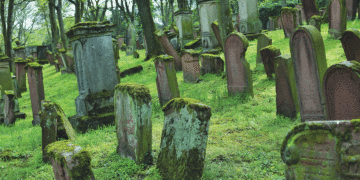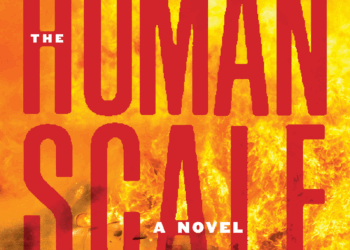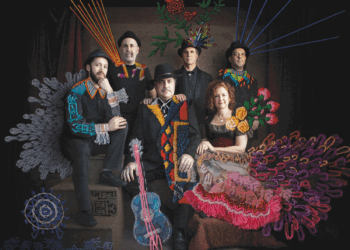Reviewed by NEAL GENDLER
Josef Lewkowicz, a survivor of the notorious Płaszów concentration camp and five others, says he’s no hero despite having found the camp’s vicious commandant, Amon Göth, hiding as an ordinary soldier in a prisoner of war camp.
Lewkowicz was 16 when occupying Germans removed Jews from his 80-percent Jewish town in southeast Poland, where he’d been stealing and trading to feed his family. His parents, three younger brothers and the relatives he knew would vanish into the Nazi horror. By war’s end, only he was left.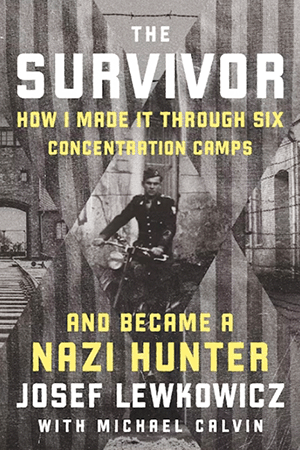
“As I have grown older, I have sometimes felt I am studying another person who exists in historical archives,” he says in The Survivor, co-authored with award-winning writer Michael Calvin.
Those documents “chart my life in captivity, which could have been extinguished for any reason, at any time, in a number of places.” Although incomplete, “they shed light on the bureaucracy of persecution.”
Płaszów, famous from the movie Schindler’s List, was a place of bestiality and “annihilation through work,” he says. “The worst guards were Ukrainian members of the SS.” Göth would shoot prisoners for any reason or none. Lewkowicz arrived as Płaszów was to be built on the site of two Jewish cemeteries.
Earth movers gouged out the graves. “It was my job to shovel up remains, bones, skulls, teeth and scraps of humanity into a wheelbarrow.”
But Płaszów wasn’t the worst of the six camps.
That was the last: Mauthausen.
Documents “tell me I was one of 4,590 Jews who arrived at Mauthausen, one of the war’s most notorious concentration camps, on Aug. 10, 1944,” one of 190,000 people, from 40 nations, sent to “the only Grade III camp, the worst category in the Nazi system.”
Mauthausen was a quarry where “prisoners were systematically worked to death,” he says. Prisoners split rocks from a large granite face, then split them into blocks of about 110 pounds to be carried 101 feet upward on the 186-step “stairway of death.”
Death was everywhere: starvation, disease, exhaustion and falls from the granite face or on the steps, where one man falling could knock down those behind him like dominoes. Guards at the top sometimes amused themselves by pushing prisoners over the edge of the cliff.
Aug. 16, he was moved to a subcamp called Melk.
He likely survived by audacity.
One day during roll call, Lewkowicz — always in the front row because he was so small — found himself facing the commandant, Julius Ludolf. Taking a huge chance, Lewkowicz repeated an offer he’d made to a cruel collaborator at Płaszów: Shine his boots, which he did there twice a week, for bits of food.
He was escorted to Ludolf’s villa, where he not only shined Ludolf’s extensive footwear but went daily for chores. Feeding caged rabbits and other outdoor animals grew into household tasks where he could steal food waste and then food, smuggling some to barracks mates and using some for trading.
“I quickly found myself at the center of a web of conflicting interests, bartering and petty corruption, which we called ‘organizing,’” and risking betrayal.
May 5, the guards fled, leaving weapons. Prisoners killed more than 50 of the cruelest kapos, burning one alive in the crematorium. Prisoners broke into storerooms; several hundred died by overeating before U.S. soldiers arrived.
Three days later, Lewkowicz and a few others found Ludolf near another subcamp, pretending to be a peasant. He was tried and hung.
Lewkowicz, without home, family or occupation, became a DP camp policeman, then part of an oddly uniformed U.S. Army operation traveling Austria and Germany to find and arrest Nazis.
“I discovered Göth skulking, in disguise,” Lewkowicz says. “I testified at his war-crimes trial. He was hanged in September 1946.”
Lewkowicz quit after being reprimanded for having assaulted Göth at capture. He joined an organization looking for Jewish children that parents had spared from death by hiding them with gentile families or religious orders.
It was difficult work in antisemitic Poland, but coincidence led Lewkowicz to a distant cousin his mother once helped. The woman, tearfully happy to see him, was married to a member of Communist Poland’s politburo. Lewkowicz turned this connection into authorization for his team to seek such children and, accompanied by plainclothes and uniformed secret police, remove them for placement with other hidden children being reintroduced to being Jews. It sometimes was unpleasant work.
Survivor continues with Lewkowicz’s immigration to South America, where he became successful in the diamond business, his marriage and his moves to Canada and Israel.
This assisted autobiography occasionally seems a bit self-glorifying, but in a foreword, filmmaker and journalist Jonathan Kalmus is credited with having “sifted through 100,000 documents to build the essential evidence base to historical verify Josef’s past.”
Although from a major publisher, Survivor has the plain look of self-publication. It has photos, but no index and a few small errors. For example, “kipa” is singular, not “skullcaps,” and a Chumash is the five books of Moses, not “special readings” from them.
Survivor is easy to read — sometimes seeming stream of consciousness — but because Josef is so straightforward, its camp details can be disturbing. People need to know them.
***
Neal Gendler is a Minneapolis writer and editor.
(American Jewish World, April 2025)


